Lenovo G430, G530 User Manual
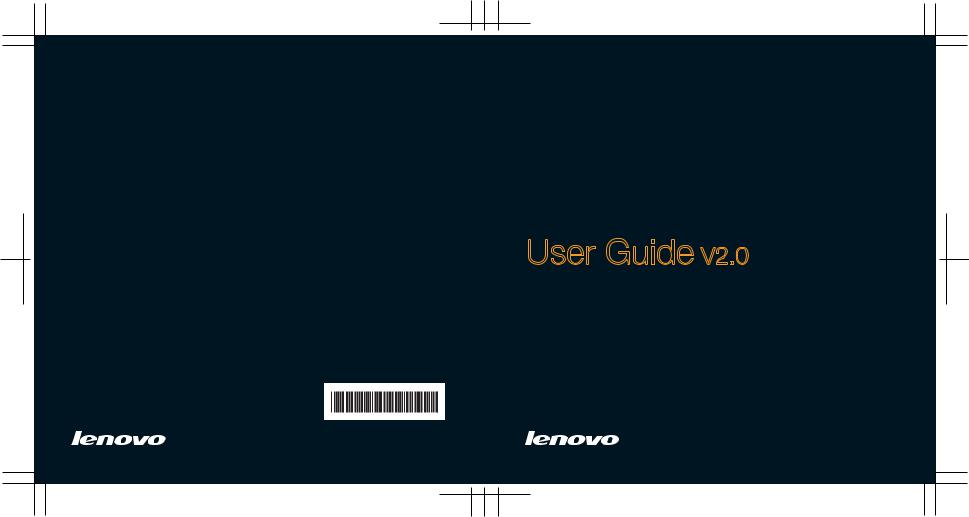
New World. New Thinking.
www.lenovo.com
2008 China ©Lenovo
P/N: 147002152
Printed in China
Lenovo 3000 G430/G530 UG V1.0 cover_en_1-4
Lenovo
3000 G430/
G530
User Guide V2.0
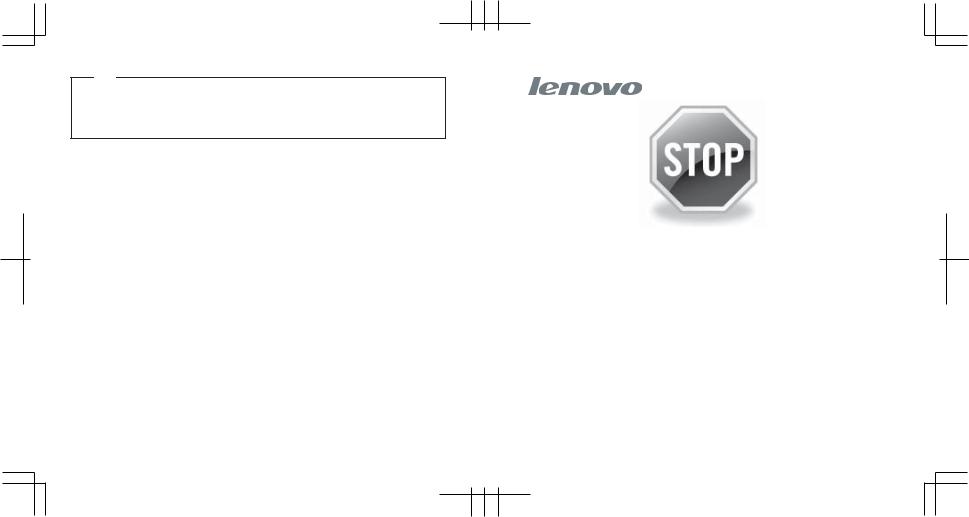
Lenovo 3000 G430/G530 UG V1.0 cover_en_2-3
Note
Before using this information and the product it supports, be sure to read the following:
•Chapter 6. Safety, Use, and Care Information on page 62.
•Appendix D. Notices on page 110.
•OneKey Rescue System User Guide included in the package with this publication.
First Edition (May 2008)
© Copyright Lenovo 2008. All rights reserved.
U.S. GOVERNMENT USERS – RESTRICTED RIGHTS: Our products and/or services are provided with RESTRICTED RIGHTS. Use, duplication or disclosure by the Government is subject to the GSA ADP Schedule contract with Lenovo, if any, or the standard terms of this commercial license, or if the agency is unable to accept this Program under these terms, then we provide this Program under the provisions set forth in Commercial Computer Software–Restricted Rights at FAR 52.227-19, when applicable, or under Rights in Data-General, FAR 52.227.14 (Alternate III).
If your product is not working correctly,
DO NOT RETURN IT TO THE STORE.
For technical assistance, contact a Lenovo support specialist 24 hours a day by calling toll free 1-877-4
LENOVO (1-877-453-6686).
Additionally, you can find support information and updates on the Lenovo Web site located at http://consumersupport.lenovo.com.
* Only for the users from the United States.

 /HQRYR * * 8* 9 BHQ ERRN 3DJH 7KXUVGD\ 6HSWHPEHU 30
/HQRYR * * 8* 9 BHQ ERRN 3DJH 7KXUVGD\ 6HSWHPEHU 30
ENERGY STAR model information
ENERGY STAR® is a joint program of the U.S. Environmental Protection Agency and the U.S. Department of Energy aimed at saving money and protecting the environment through energy efficient products and practices.
Lenovo is proud to offer our customers products with an ENERGY STAR compliant designation. Lenovo computers of the following machine types, if the ENERGY STAR mark is affixed, have been designed and tested to conform to the ENERGY STAR 4.0 program requirements for computers.
•20003, 4153
•20004, 4151
By using ENERGY STAR compliant products and taking advantage of the power-management features of your computer, you reduce the consumption of electricity. Reduced electrical consumption contributes to potential financial savings, a cleaner environment, and the reduction of greenhouse gas emissions.
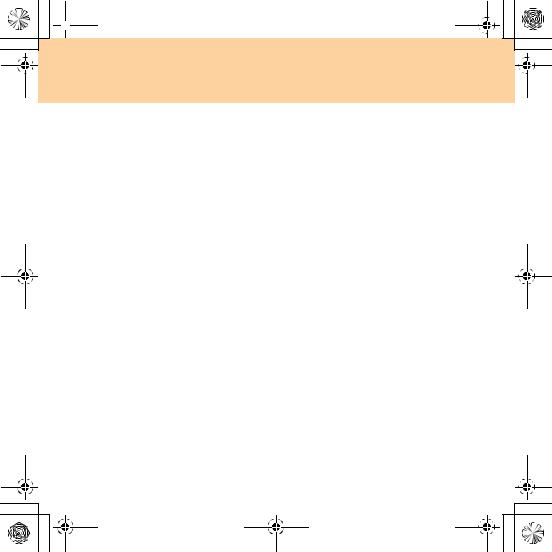
 /HQRYR * * 8* 9 BHQ ERRN 3DJH 7KXUVGD\ 6HSWHPEHU 30
/HQRYR * * 8* 9 BHQ ERRN 3DJH 7KXUVGD\ 6HSWHPEHU 30
For more information about ENERGY STAR, visit http://www.energystar.gov.
Lenovo encourages you to make efficient use of energy an integral part of your day-to-day operations. To help in this endeavor, Lenovo has preset the following power-management features to take effect when your computer has been inactive for a specified duration:
Table 1. ENERGY STAR power-management features, by operating system
Windows XP |
Windows Vista |
|
|
• Turn off monitor: After 10 |
Power plan: Balanced |
minutes |
• Turn off the display: After 10 |
• Turn off hard disks: After 30 |
minutes |
minutes |
• Put the computer to sleep: After |
• System standby: After 20 minutes |
25 minutes |
• System hibernates: After 2 hours |
• Advanced power settings: |
|
- Turn off hard disks: After 20 |
|
minutes |
|
- Hibernate: After 1 hour |
|
|
To awaken your computer from a Sleep or System Standby mode, press any key on your keyboard. For more information about these settings, refer to your Windows Help and Support information system.
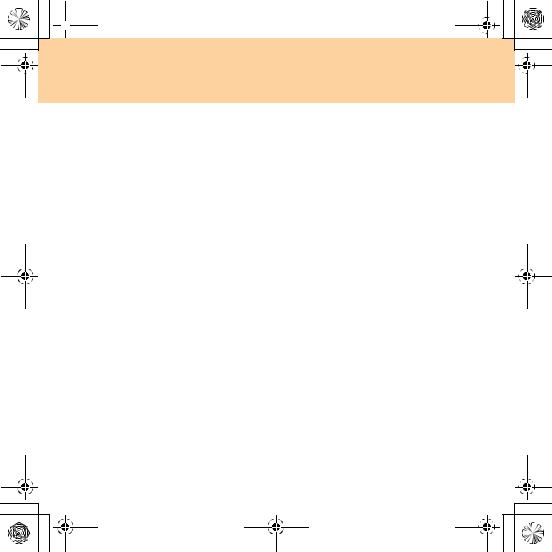
 /HQRYR * * 8* 9 BHQ ERRN 3DJH 7KXUVGD\ 6HSWHPEHU 30
/HQRYR * * 8* 9 BHQ ERRN 3DJH 7KXUVGD\ 6HSWHPEHU 30
Explanation of Hard Disk Capacity
Dear user,
While using your computer, you may discover that the nominal hard disk capacity indicated is somewhat different from the disk capacity displayed by the operating system. For example, a nominal 80GB hard disk will appear as less than 80GB in the operating system. This discrepancy is not an error in hard disk installation nor any other problem, but a normal phenomenon of computers. This phenomenon is primarily due to the following reasons:
I.Different standards used by the manufacturer and operating system when calculating hard disk capacity
Hard disk manufacturers use a radix of 1000, i.e. 1G = 1,000MB, 1MB = 1,000KB, 1KB = 1,000 bytes. However, when identifying hard disk capacity, operating systems use a radix of 1024, i.e. 1GB = 1,024MB, 1MB = 1,024KB, 1KB = 1,024 bytes. The standard adopted by your computer is that of the hard disk manufacturers. Since the standards adopted by the hard disk manufacturer and operating system are different, the hard disk capacity displayed by the operating system will be different from the nominal hard disk capacity.
For example, if the hard disk is nominally X G, even when it is completely
empty, the capacity displayed by the operating system will be: X × 1000 × 1000 × 1000/ (1024 × 1024 × 1024) ≈ X × 0.931 G

 /HQRYR * * 8* 9 BHQ ERRN 3DJH 7KXUVGD\ 6HSWHPEHU 30
/HQRYR * * 8* 9 BHQ ERRN 3DJH 7KXUVGD\ 6HSWHPEHU 30
If a portion of the hard disk space has been used for some specific purpose, then the capacity indicated by the operating system will be even less than X × 0.931 G.
II.A portion of the hard disk space is used for specific purposes
Lenovo computers come with preinstalled OneKey Rescue System, so the hard disk has a special portion partitioned before delivery, which is used to store hard disk mirror and OneKey Rescue System program files. The size of the reserved space for this partition varies according to the model, operating system and software of the computer. For the sake of safety, this partition is not evident, which is commonly referred to as a “hidden partition”.
In addition, after the hard disk is partitioned or formatted, the system will assign a certain amount of hard disk space for the system files.
For the above reasons, the available hard disk space indicated by the operating system is always less than the computer’s nominal hard disk capacity.
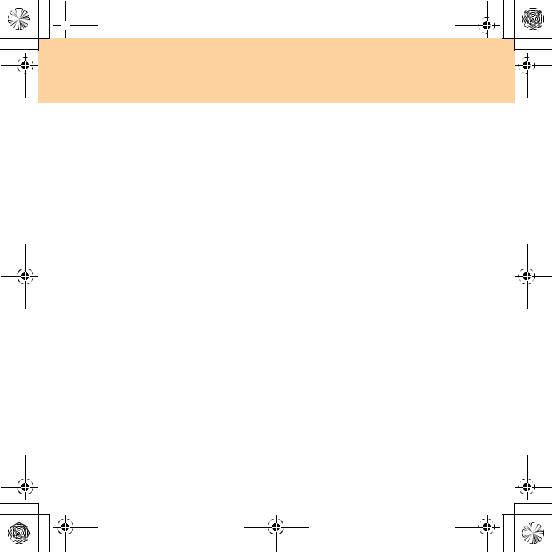
 /HQRYR * * 8* 9 BHQ ERRN 3DJH L 7KXUVGD\ 6HSWHPEHU 30
/HQRYR * * 8* 9 BHQ ERRN 3DJH L 7KXUVGD\ 6HSWHPEHU 30
Contents |
|
Chapter 1. Getting to Know Your |
|
Computer ...................................... |
1 |
Top View ....................................... |
1 |
Left-side View ............................... |
3 |
Right-side View ............................ |
5 |
Front View ..................................... |
6 |
Bottom View.................................. |
7 |
Chapter 2. Using Your |
|
Computer .................................... |
10 |
Putting Your Computer to Sleep |
|
or Shutting It Down ................... |
10 |
Using the Touch Pad.................. |
11 |
Using the Keyboard ................... |
12 |
Special Keys and Buttons .......... |
15 |
Using the Optical Drive............. |
17 |
Using Memory Cards |
|
(Specific model only) ................. |
18 |
Using the Integrated Camera |
|
(Specific model only) ................. |
19 |
Using the Internet....................... |
20 |
Securing Your Computer .......... |
23 |
Installing Device Drivers........... |
31 |
Using the Battery and AC |
|
Adapter ........................................ |
32 |
Chapter 3. Using External |
|
Devices ........................................ |
37 |
Connecting a Universal Serial Bus |
|
(USB) Device ............................... |
37 |
Connecting a PC Card |
|
Device........................................... |
38 |
Connecting an External |
|
Display ......................................... |
40 |
Connecting a Headphone and |
|
Audio Device .............................. |
42 |
Connecting an External |
|
Microphone ................................. |
43 |
Connecting a Bluetooth Device |
|
(Specific model only).................. |
44 |
Chapter 4. Troubleshooting ....... |
45 |
Frequently Asked Questions .... |
45 |
Troubleshooting.......................... |
47 |
Chapter 5. Getting Help and Ser- |
|
vice ............................................... |
57 |
Getting Help and Service .......... |
57 |
Getting Help on the Web........... |
58 |
Calling the Customer Support |
|
Center ........................................... |
58 |
Getting Help Around the |
|
World............................................ |
61 |
|
i |
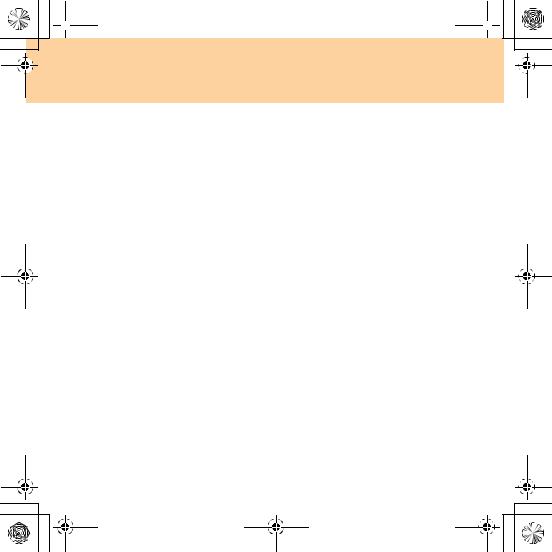
 /HQRYR * * 8* 9 BHQ ERRN 3DJH LL 7KXUVGD\ 6HSWHPEHU 30
/HQRYR * * 8* 9 BHQ ERRN 3DJH LL 7KXUVGD\ 6HSWHPEHU 30 
Contents
Chapter 6. Safety, Use, and Care |
|
Information.................................. |
62 |
Important Safety |
|
Information ................................. |
62 |
Caring Your Computer ............. |
79 |
Accessibility and Comfort ........ |
87 |
Maintenance................................ |
90 |
Appendix A. Lenovo Limited |
|
Warranty...................................... |
94 |
Warranty Information ............. |
102 |
Lenovo Warranty Service |
|
Telephone Numbers ................ |
105 |
Appendix B. Customer |
|
Replaceable Units (CRUs) ....... |
107 |
Appendix C. Specifications ..... |
108 |
Specifications ............................ |
108 |
Appendix D. Notices ................ |
110 |
Notices ....................................... |
110 |
Wireless related |
|
information ............................... |
113 |
Electronic Emissions |
|
Notices ....................................... |
116 |
WEEE and Recycling |
|
Statements ................................. |
122 |
EU WEEE Statements .............. |
123 |
Japan Recycling Statements.... |
124 |
Notice for Users in the |
|
U.S.A. ......................................... |
126 |
Notice on Deleting Data from |
|
Your Hard Disk ........................ |
126 |
Trademarks ............................... |
128 |
Index........................................... |
129 |
ii

 /HQRYR * * 8* 9 BHQ ERRN 3DJH 7KXUVGD\ 6HSWHPEHU 30
/HQRYR * * 8* 9 BHQ ERRN 3DJH 7KXUVGD\ 6HSWHPEHU 30
Chapter 1. Getting to Know Your Computer
 Top View ------------------------------------------------------------------------------------------
Top View ------------------------------------------------------------------------------------------
a
|
f |
b |
g |
|
|
c |
e |
|
|
d |
|
e |
|
* The illustrations in this manual may differ from the actual product.
1
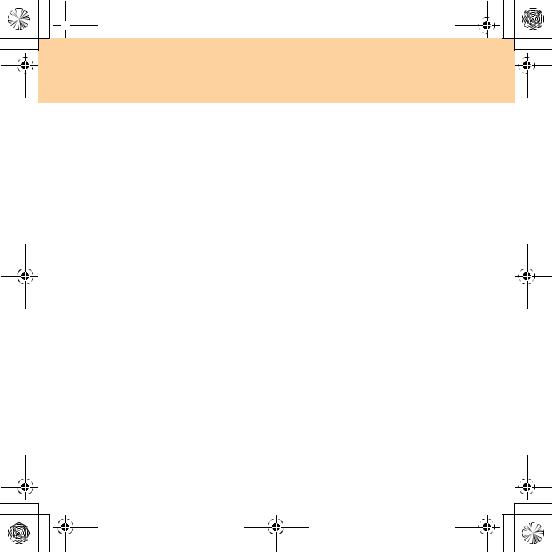
 /HQRYR * * 8* 9 BHQ ERRN 3DJH 7KXUVGD\ 6HSWHPEHU 30
/HQRYR * * 8* 9 BHQ ERRN 3DJH 7KXUVGD\ 6HSWHPEHU 30
Chapter 1. Getting to Know Your Computer |
|
Integrated camera (Specific model only) ....................................... |
19 |
Computer display |
|
The color display with TFT technology provides clear and brilliant text and graphics.
OneKey Rescue System button ...................................................... |
16 |
Power button
Use the Power button to turn on the computer.
System status indicators
The system status indicators show the current status of your computer.
Microphone (built-in)
The built-in microphone can be used for video conferencing, voice narration, or simple audio recordings.
Custom and volume buttons........................................................... |
15 |
2
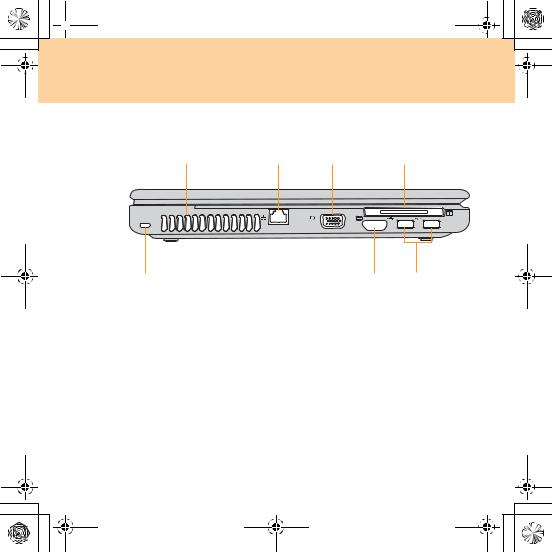
 /HQRYR * * 8* 9 BHQ ERRN 3DJH 7KXUVGD\ 6HSWHPEHU 30
/HQRYR * * 8* 9 BHQ ERRN 3DJH 7KXUVGD\ 6HSWHPEHU 30
Chapter 1. Getting to Know Your Computer
 Left-side View -----------------------------------------------------------------------------
Left-side View -----------------------------------------------------------------------------
a b c d
e |
f |
g |
3

 /HQRYR * * 8* 9 BHQ ERRN 3DJH 7KXUVGD\ 6HSWHPEHU 30
/HQRYR * * 8* 9 BHQ ERRN 3DJH 7KXUVGD\ 6HSWHPEHU 30
Chapter 1. Getting to Know Your Computer
Fan louvers
The fan louvers allow heated air to exit the computer.
Important:
Make sure that paper, books, clothing, cables or other objects do not block any of the fan louvers otherwise, overheating of the computer may occur.
LAN port............................................................................................ |
20 |
VGA port ........................................................................................... |
40 |
PCI Express card slot ...................................................................... |
38 |
Security keyhole
Your computer comes with a security keyhole. You can purchase a security cable and lock to fit this keyhole.
Note:
Before purchasing any security product, verify that it is compatible with this type of security keyhole.
HDMI port (Specific model only)..................................................... |
41 |
Use this connector to connect HDMI devices.
USB 2.0 port ..................................................................................... |
37 |
4
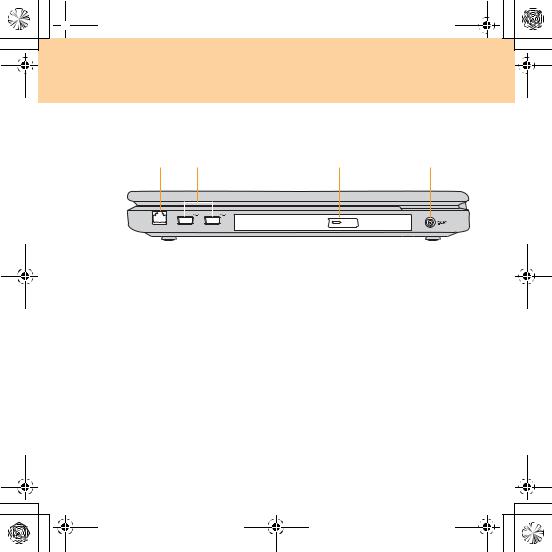
 /HQRYR * * 8* 9 BHQ ERRN 3DJH 7KXUVGD\ 6HSWHPEHU 30
/HQRYR * * 8* 9 BHQ ERRN 3DJH 7KXUVGD\ 6HSWHPEHU 30
Chapter 1. Getting to Know Your Computer
 Right-side View --------------------------------------------------------------------------
Right-side View --------------------------------------------------------------------------
a b* c d
* G430 has one USB port here. |
|
Modem Port (Specific model only) ................................................. |
22 |
USB 2.0 port ..................................................................................... |
37 |
Optical drive ..................................................................................... |
17 |
AC power adapter jack |
|
Connect the power adapter here to supply power to the computer and charge the internal battery.
Note:
To prevent damage to the computer and battery pack, use the supplied AC adapter only.
5
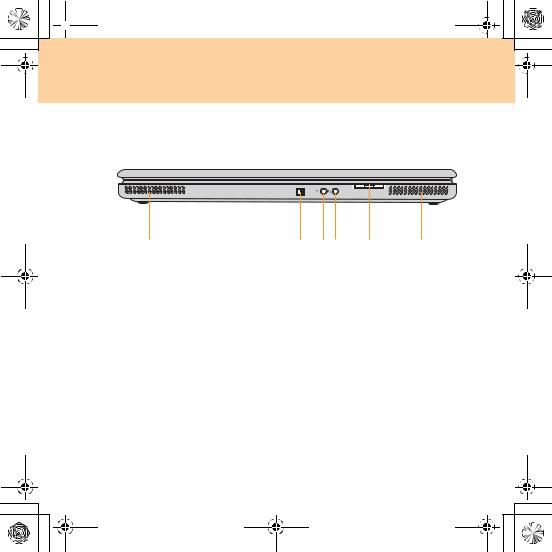
 /HQRYR * * 8* 9 BHQ ERRN 3DJH 7KXUVGD\ 6HSWHPEHU 30
/HQRYR * * 8* 9 BHQ ERRN 3DJH 7KXUVGD\ 6HSWHPEHU 30
Chapter 1. Getting to Know Your Computer
 Front View --------------------------------------------------------------------------------------
Front View --------------------------------------------------------------------------------------
a |
b cd |
e |
a |
Speakers
Built-in speakers for rich powerful sound.
Wireless device switch (Specific model only)
Use this switch to simultaneously turn on or turn off Wireless LAN and Bluetooth devices.
Microphone jack (external).............................................................. |
43 |
Headphone (external) ...................................................................... |
42 |
Multi-media reader slot (Specific model only) .............................. |
18 |
6
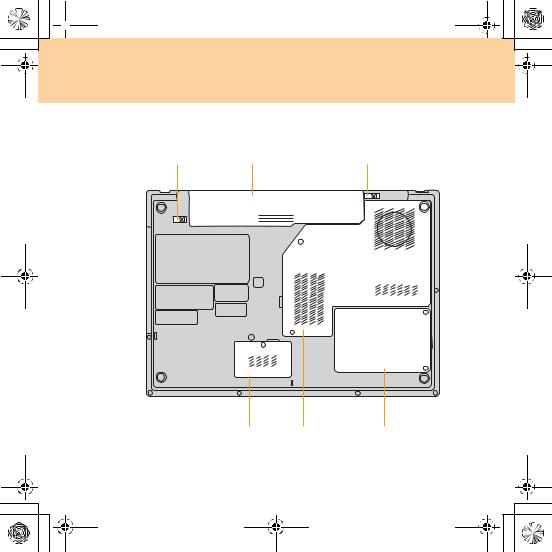
 /HQRYR * * 8* 9 BHQ ERRN 3DJH 7KXUVGD\ 6HSWHPEHU 30
/HQRYR * * 8* 9 BHQ ERRN 3DJH 7KXUVGD\ 6HSWHPEHU 30
Chapter 1. Getting to Know Your Computer
 Bottom View ---------------------------------------------------------------------------------
Bottom View ---------------------------------------------------------------------------------
a b c
d |
e |
f |
7
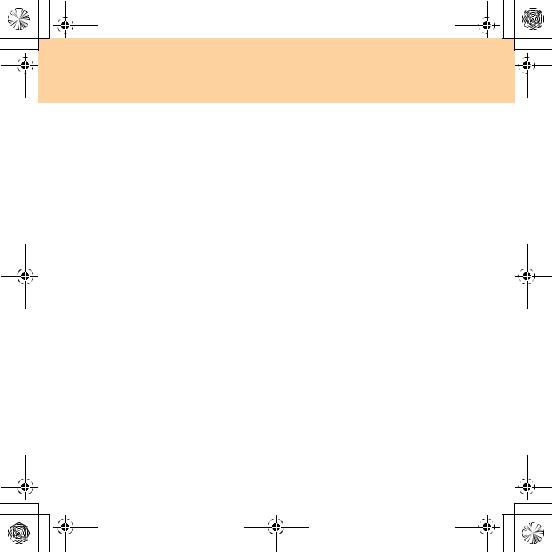
/HQRYR * * 8* 9 BHQ ERRN 3DJH 7KXUVGD\ 6HSWHPEHU 30
Chapter 1. Getting to Know Your Computer
Battery latch - manual
The manual battery latch is used to keep the battery pack secured. Move the manual battery latch to the unlocked position to insert or remove the battery pack. Move the manual latch to the locked position after inserting the battery pack.
Battery pack ..................................................................................... |
32 |
Battery latch - spring loaded
The spring-loaded battery latch keeps the battery pack secured in place. When you insert a battery pack, this latch automatically secures the battery in place. To remove the battery, hold this latch in the unlocked position.
WLAN and WWAN cards compartment
The wireless network cards (Specific model only) can be secured in this compartment for easy access.
Central Processor Unit (CPU)/ Memory (RAM) compartment
Central Processor Unit (CPU)
The CPU compartment provides space for the CPU and the radiator.
8
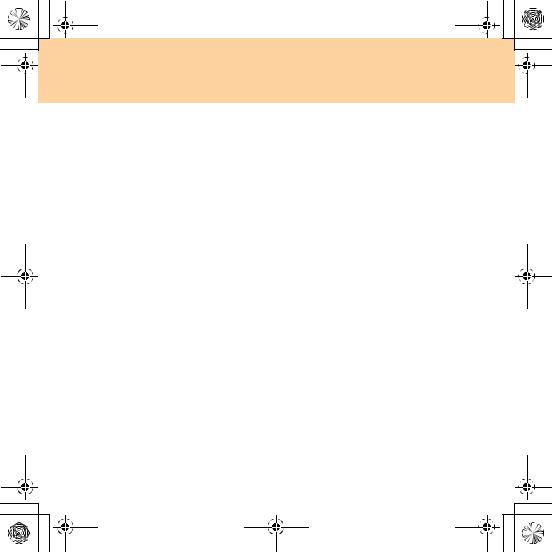
/HQRYR * * 8* 9 BHQ ERRN 3DJH 7KXUVGD\ 6HSWHPEHU 30
Chapter 1. Getting to Know Your Computer
Important:
Do not replace the CPU! Visit an authorized service center or retailer for replacement.
Memory (RAM) compartment
The memory compartment provides expansion capabilities for additional memory. The BIOS automatically detects the amount of memory in the system and configures CMOS accordingly during the Power-On Self-Test (POST) process. There is no hardware or software (including BIOS) setup required after the memory is installed.
Note:
(1)Only purchase expansion modules from authorized retailers of this computer to ensure maximum compatibility and reliability.
(2)If you only insert one memory card in the compartment, plug it into the slot near the mainboard.
Hard Disk Drive compartment
The hard disk drive is secured in this compartment.
Important:
Do not disassemble or replace the hard disk drive! If you should ever need to, ask a Lenovo authorized service center or dealer to provide this service.
9
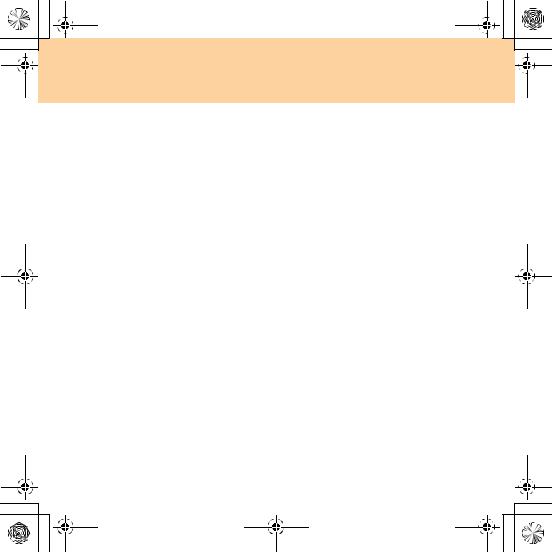
/HQRYR * * 8* 9 BHQ ERRN 3DJH 7KXUVGD\ 6HSWHPEHU 30 |
Chapter 2. Using Your Computer
 Putting Your Computer to Sleep or Shutting It Down -
Putting Your Computer to Sleep or Shutting It Down -
When you finish working with your computer, you can put it to sleep or shut it down.
Putting Your Computer to Sleep
If you will be away from your computer for only a short time, put the computer to sleep. When the computer is in sleep state, you can quickly wake it to resume use, and bypass the startup process.
To put the computer to sleep, do one of the following.
Click Start and select Sleep from the Start menu.
Press Fn + F1.
Warning:
Wait until the power indicator light starts blinking (indicating that the computer is in sleep state) before you move your computer. Moving your computer while the hard disk is spinning can damage the hard disk, causing loss of data.
To wake the computer, do one of the following.
Press the power button.
Press any key.
Shutting Down Your Computer
If you are not going to use your computer for a day or two, shut it down. To shut down your computer, click Start and select Shut down from the Start menu.
10
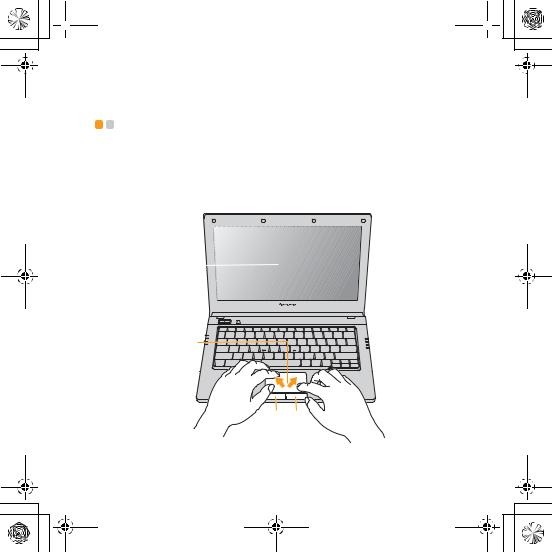
 /HQRYR * * 8* 9 BHQ ERRN 3DJH 7KXUVGD\ 6HSWHPEHU 30
/HQRYR * * 8* 9 BHQ ERRN 3DJH 7KXUVGD\ 6HSWHPEHU 30 
|
Chapter 2. Using Your Computer |
|
|
Using the Touch Pad ------------------------------------------------------------------ |
|
The touch pad consists of a pad |
and two click buttons at the bottom of |
the keyboard. To move the cursor |
on the screen, slide your fingertip |
over the pad in the direction in which you want the cursor to move. The
functions of the left and right click buttons correspond to those of the left and right mouse buttons on a conventional mouse.
b

a
cd
11
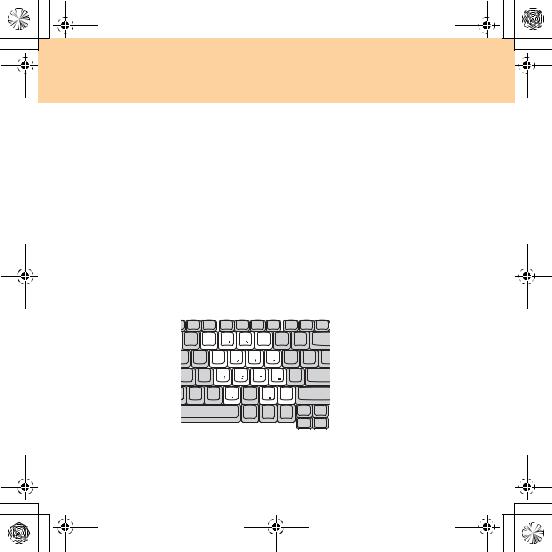
/HQRYR * * 8* 9 BHQ ERRN 3DJH 7KXUVGD\ 6HSWHPEHU 30 |
Chapter 2. Using Your Computer
Note:
You can also attach and use a USB mouse through the USB connector.
For details, see “Connecting a Universal Serial Bus (USB) Device” on page 37.
 Using the Keyboard --------------------------------------------------------------------
Using the Keyboard --------------------------------------------------------------------
Your computer has a numeric keypad and function keys incorporated in the standard keyboard.
Numeric Keypad
The keyboard has keys that, when enabled, work as a 10-key numeric keypad.
To enable or disable the numeric keypad, press Fn+Insert/NmLk.
* The illustrations in this manual may differ from the actual product.
12
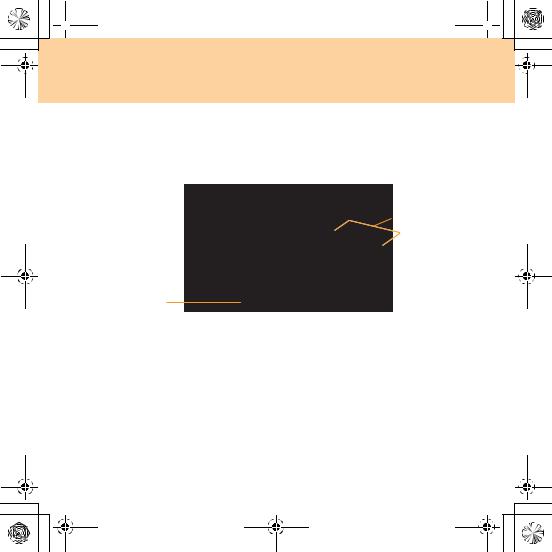
 /HQRYR * * 8* 9 BHQ ERRN 3DJH 7KXUVGD\ 6HSWHPEHU 30
/HQRYR * * 8* 9 BHQ ERRN 3DJH 7KXUVGD\ 6HSWHPEHU 30 
Chapter 2. Using Your Computer
Function Key Combinations
Through the use of the function keys, perform useful operations more efficiently. To use this feature, press and hold the Fn key , then press one of the function keys .
b
a
13
